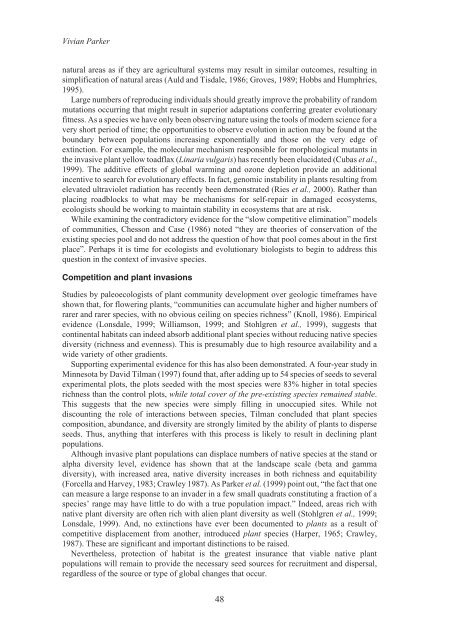Alien Species.vp - IUCN
Alien Species.vp - IUCN
Alien Species.vp - IUCN
You also want an ePaper? Increase the reach of your titles
YUMPU automatically turns print PDFs into web optimized ePapers that Google loves.
Vivian Parker<br />
natural areas as if they are agricultural systems may result in similar outcomes, resulting in<br />
simplification of natural areas (Auld and Tisdale, 1986; Groves, 1989; Hobbs and Humphries,<br />
1995).<br />
Large numbers of reproducing individuals should greatly improve the probability of random<br />
mutations occurring that might result in superior adaptations conferring greater evolutionary<br />
fitness. As a species we have only been observing nature using the tools of modern science for a<br />
very short period of time; the opportunities to observe evolution in action may be found at the<br />
boundary between populations increasing exponentially and those on the very edge of<br />
extinction. For example, the molecular mechanism responsible for morphological mutants in<br />
the invasive plant yellow toadflax (Linaria vulgaris) has recently been elucidated (Cubas et al.,<br />
1999). The additive effects of global warming and ozone depletion provide an additional<br />
incentive to search for evolutionary effects. In fact, genomic instability in plants resulting from<br />
elevated ultraviolet radiation has recently been demonstrated (Ries et al., 2000). Rather than<br />
placing roadblocks to what may be mechanisms for self-repair in damaged ecosystems,<br />
ecologists should be working to maintain stability in ecosystems that are at risk.<br />
While examining the contradictory evidence for the “slow competitive elimination” models<br />
of communities, Chesson and Case (1986) noted “they are theories of conservation of the<br />
existing species pool and do not address the question of how that pool comes about in the first<br />
place”. Perhaps it is time for ecologists and evolutionary biologists to begin to address this<br />
question in the context of invasive species.<br />
Competition and plant invasions<br />
Studies by paleoecologists of plant community development over geologic timeframes have<br />
shown that, for flowering plants, “communities can accumulate higher and higher numbers of<br />
rarer and rarer species, with no obvious ceiling on species richness” (Knoll, 1986). Empirical<br />
evidence (Lonsdale, 1999; Williamson, 1999; and Stohlgren et al., 1999), suggests that<br />
continental habitats can indeed absorb additional plant species without reducing native species<br />
diversity (richness and evenness). This is presumably due to high resource availability and a<br />
wide variety of other gradients.<br />
Supporting experimental evidence for this has also been demonstrated. A four-year study in<br />
Minnesota by David Tilman (1997) found that, after adding up to 54 species of seeds to several<br />
experimental plots, the plots seeded with the most species were 83% higher in total species<br />
richness than the control plots, while total cover of the pre-existing species remained stable.<br />
This suggests that the new species were simply filling in unoccupied sites. While not<br />
discounting the role of interactions between species, Tilman concluded that plant species<br />
composition, abundance, and diversity are strongly limited by the ability of plants to disperse<br />
seeds. Thus, anything that interferes with this process is likely to result in declining plant<br />
populations.<br />
Although invasive plant populations can displace numbers of native species at the stand or<br />
alpha diversity level, evidence has shown that at the landscape scale (beta and gamma<br />
diversity), with increased area, native diversity increases in both richness and equitability<br />
(Forcella and Harvey, 1983; Crawley 1987). As Parker et al. (1999) point out, “the fact that one<br />
can measure a large response to an invader in a few small quadrats constituting a fraction of a<br />
species’ range may have little to do with a true population impact.” Indeed, areas rich with<br />
native plant diversity are often rich with alien plant diversity as well (Stohlgren et al., 1999;<br />
Lonsdale, 1999). And, no extinctions have ever been documented to plants as a result of<br />
competitive displacement from another, introduced plant species (Harper, 1965; Crawley,<br />
1987). These are significant and important distinctions to be raised.<br />
Nevertheless, protection of habitat is the greatest insurance that viable native plant<br />
populations will remain to provide the necessary seed sources for recruitment and dispersal,<br />
regardless of the source or type of global changes that occur.<br />
48












